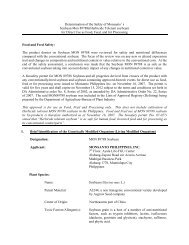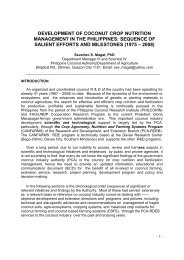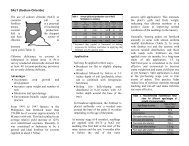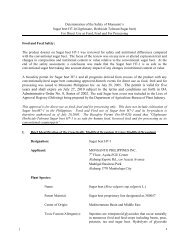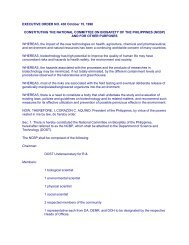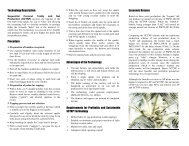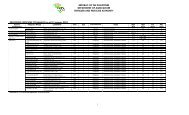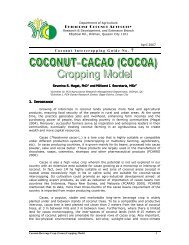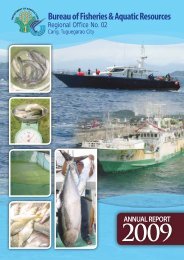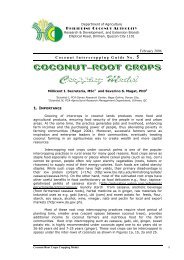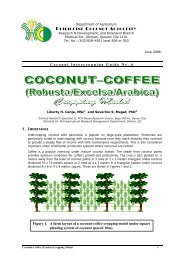Department of Agriculture - Philippine Coconut Authority
Department of Agriculture - Philippine Coconut Authority
Department of Agriculture - Philippine Coconut Authority
Create successful ePaper yourself
Turn your PDF publications into a flip-book with our unique Google optimized e-Paper software.
<strong>Department</strong> <strong>of</strong> <strong>Agriculture</strong>P HILIPPINE C OCONUT A UTHORITYResearch & Development, and Extension BranchElliptical Rd., Diliman, Quezon City 1101<strong>Coconut</strong> Intercropping Guide No. 11. IMPORTANCEGrowing <strong>of</strong> intercrops in coconut lands produces more food and agriculturalproducts, providing food security for the people in both the rural and urban areas. Atthe same time, the practice generates jobs and livelihood, likewise enhancing farmincome and purchasing power <strong>of</strong> people, thus alleviating poverty in farmingcommunities.Corn, an annual or short season cereal crop is commonly planted under andbetween coconut trees. To be productive and economically, the crop is best plantedat least 2 meters away from the base <strong>of</strong> trees. Moreover, where there is a scare landresource for planting corn, coconut lands <strong>of</strong>fer a practical opportunity as theinterspaces between rows <strong>of</strong> coconut can accommodate about 6 – 9 rows <strong>of</strong> corn,depending on the spacing or distance <strong>of</strong> coconut, that is 8 to 10 meters (square ortriangular planting systems). These are shown in Figures 1 and 2.Figure 1. A farm layout <strong>of</strong> a coconut-corn cropping model under squareplanting system <strong>of</strong> coconut 8-10 m)<strong>Coconut</strong>-Cereal (Corn) Cropping Model 1
Figure 2. A farm layout <strong>of</strong> a coconut-corn cropping model under triangularplanting system <strong>of</strong> coconut 8-10 m)2. BENEFITS<strong>Coconut</strong> trees – produces many basic food products and non-food rawmaterials for high value products. If there is regular or seasonal demand for tender8-month old nuts (buko) for tender nut water (buko juice) and tender nut for piesand desserts, the farmers get higher net income compared to the 12-month oldmature nuts as buko nuts are usually priced 3-4 times higher than mature nuts.Corn crop - either harvested at green stage or mature stage, depending onthe local demand. Corn remains a staple cereal food (30%) in many regions incountry. The remaining 70% is processed into feeds for swine and poultryproduction. Corn constitutes at least 60% <strong>of</strong> commercial feed ingredients andcontributes about 70% <strong>of</strong> cost in raising hogs and chicken (DOST-PCARRD 1998). Itis also a major material in the manufacture <strong>of</strong> starch, gluten and alcohol.Under the coconut-corn cropping, yield <strong>of</strong> coconut <strong>of</strong> two (2) tonscopra and five (5) tons <strong>of</strong> corn grains (2 cropping/year), the totalinvestment <strong>of</strong> P22,050 generates a net return <strong>of</strong> about P42,950 per year or abenefit/cost ratio <strong>of</strong> 2:1.3. MARKET DEMAND AND PRACTICESOver the years, average annual national demand for corn is 6 M tons (52% forlivestock feed industry), while total gross supply is 4. 2 M tons only, with 100,000tons importation, annually (DOST-PCARRD 1998).Marketing agents include farmers, local assemblers, millers, grain wholesaledealers, wholesale millers, feed millers and retailers. Historically, the domesticwholesale price <strong>of</strong> corn has been higher than the world prices by about 50%. Underthe GATT agreement, the committed tariff rate <strong>of</strong> 100% adequately protect domesticproducers from corn importers.<strong>Coconut</strong>-Cereal (Corn) Cropping Model 2
4. GROWING CONDITIONS AND THE TECHNOLOGY4.1 Environmental RequirementsTo optimize the corn yield and achieve maximum economic benefits fromcoconut-corn cropping, it is essential to provide the proper climatic and soilsconditions on both main and intercrop crop. If not, marginal net returns is notuncommon in farms, mainly as a result <strong>of</strong> the competition for natural land resources.Climatic Needs:Climatic Factors <strong>Coconut</strong> CornAltitude (m above sealevel) Less than 600 Less than 600Temperature ( o C) 24-29 18-32Relative Humdity (%) 80-90 -ditto-Light >2000 sunshine hrs 3000 - 8000 ft-candlesTotal annual rainfall (mm)1500-2500 (welldistributed)Typhoon frequency (%) 75 >50Drainage Moderate to well drained Well drainedSoil Acidity (pH) 5.5 – 7.5 5.2 – 7.0Soil textureSandy, loamy, clayey (with goodstructure)LoamyMajor nutrients N, K, Cl, S, P, Ca, Mg, B N, P, K, S, Ca and Zn4.2 TechnologyIt is very important to apply the best package <strong>of</strong> technologies (POT) or better thesite-specific technologies to achieve the maximum economic yield (MEY), desirable toobtain the least production cost and maximum returns to investment in the coconutcorncropping.As a comprenhensive guide on the monocropping <strong>of</strong> corn, the <strong>Philippine</strong>Recommends for Corn (PCARRD 1981) is a popular reference-manual. For coconut,two booklets were produced by the PCA as quick references: 1) ProductionManagement <strong>of</strong> <strong>Coconut</strong> (Magat 1999); and 2) <strong>Coconut</strong>-Based Farming Systems(CBFS), Technology Notes for Practicioners (Magat 1999).Following are some salient recommended farming pointers or practices in a coconutcorncropping system:<strong>Coconut</strong>-Cereal (Corn) Cropping Model 3
CORN1. Land Preparation - plow the field once when soil is just moist, harrow twice; makefurrows at 0.75 m apart and 2 m away from base <strong>of</strong> coconut trees; practiceconservation tillage (zero/minimum tillage), using proper herbicides as practical.2. Planting Materials – use high yielding corn variety or hybrids with good qualityseeds. Varieties found suitable under coconut are: USM varieties (2.3 – 3.6t/ha); UPLB-IPB (2-4 t/ha); SMC (2.8 – 3.6 t/ha); and Pioneer Hybrid (3.7 – 4t/ha). The nearest local <strong>of</strong>fice <strong>of</strong> the Regional Field Unit Office <strong>of</strong> the <strong>Department</strong><strong>of</strong> Agricultural (DA-RFU) and the known agricultural supply stores usually knowthe corn seed suppliers.3. Planting practice - basal fertilizer application, apply fertilizers in furrows at 3bags/ha 14-14-14 per ha and cover with thin layer <strong>of</strong> soil before seed-sowing;plant 2 seeds per hill on furrows at a distance <strong>of</strong> 20 cm between hills or 5 hills perlinear meter (about 30,000 – 48,000 plants/ha population density), then, thin toone plant per hi.ll two weeks after seed germination.4. Field Maintenance – <strong>of</strong>f-bar (plowshare away from furrows on the 14 th day afterplanting (DAP); sidedress the remaining half <strong>of</strong> the fertilizer ( 2 bags 21-0-0 orone bag urea) around 5-6 cm away from corn plants just before hilling-up; hillup(plowshare towards the furrows at 45 DAP to cover the fertilizer and controlweeds; monitor the plants for occurrence <strong>of</strong> pest ( mostly corn borer) anddiseases (downy mildew); uproot and burn affected plants immediately, and forpest infestation, spray with any available insecticides; do line-weeding asnecessary.5. Harvesting – harvest mature ears <strong>of</strong> corn at appropriate time, usually 95 – 100days from DAP when corn husks are dried.COCONUTWith the coconut trees already established and already at bearing stage, the mainfarming practices are fertilization, underbrushing-weeding, mulching <strong>of</strong> the mainrootzone <strong>of</strong> coconut (also considered the fertilizing zone at trunk base <strong>of</strong> trees), andharvesting. Post-harvest and primary processing practices (seasoning <strong>of</strong> partiallyimmature nuts for a 7 – 10 days, dehusking and copra processing) are common insmall to medium scale farms. If sold to coconut desiccating plants, dehusked areimmediately marketed. <strong>Coconut</strong> husks await decortication/defibering, while coconutshells are converted to charcoal and sold to activated carbon processors.A separate fertilization for the stands <strong>of</strong> coconut and the corn crop isrecommended. There are two average inorganic/mineral fertilizer recommendationsfor coconut: 1) using the combination <strong>of</strong> single fertilizers (ammonium sulfate pluscommon salt (for potassium-rich soils) or potassium chloride (0-0-60) for soilsdeficient in K; and 2) using ready-to-apply multinutrient fertilizers as the 14-5-20-0.02 (B), now commercially available like COCOGROW (ATLAS Brand) in 25 kg.Capacity bags.These two fertilizer recommendations are compatible with the application <strong>of</strong>appropriate organic fertilizers (compost, cocopeat, commercial organic fertilizers). Ifcapital resources to purchase organic fertilizers is available, any <strong>of</strong> these organicfertilizers ( total N, P and K <strong>of</strong> at least 5%) may be applied together with the mineralfertilizers (options 1 and 2) indicated below at the rate <strong>of</strong> 3-4 times <strong>of</strong> the periodicrates indicated. Organic fertilizers should be applied about a month ahead <strong>of</strong> theapplication <strong>of</strong> the inorganic/mineral fertilizers. Organic fertilizers serve best as soilconditioners and fertilizer supplements to the coconut-corn cropping system.<strong>Coconut</strong>-Cereal (Corn) Cropping Model 4
Option 1Application <strong>of</strong> Single-Fertilizers (per tree):Age/StageRate <strong>of</strong> Fertilizer Combination aField-planting (FP)150 g AS + 160 g SC or 200g KCl6 months from FP 200 g AS + 200 g SC or 200 g KCl1 year 500 g AS + 450 g SC or 600 g KCl2 years 750 g AS + 750 g SC or 900 g KCl3 years 1.0 kg AS + 1.25 kg SC or 1.5 kg KCl4 years 1.25 kg AS + 1.35 kg SC or 1.70 kg KCl5 years and onwards 1.50 kg AS + 1.70 kg SC or 2.00 kg KCla AS – Ammonium sulfate (21-0-0);SC – Sodium chloride (common salt);KCl – Potassium chloride (0-0-60)Option 2Application <strong>of</strong> ready-to-apply multinutrientfertilizer (per tree):Age/StageRate <strong>of</strong> 14-5-20multi-nutrient Fertilizer aField-planting (FP)400 g6 months from FP 600 g1 year 1.25 kg2 years 1.50 kg3 years 2.00 kg4 years 2.50 kg5 years and onwards 3.00 kga contains 14% N, 5% P2O5, 20% K2O plus 15% Cl , 4.5%S, 0.02% Boron, Ca.<strong>Coconut</strong>-Cereal (Corn) Cropping Model 5
5. INVESTMENT NEEDS: COST AND RETURNSSimple Cost and Return Analysis <strong>of</strong> <strong>Coconut</strong>-Corn Cropping (per ha/year)Crop/ BasisCORN:Yield/ha/yr = 5 tons (2 croppings@ P7/k)Cost(P)Gross Income(P)Net Benefit(P)13,100 35,000 21,900Corn seeds, 18 kg @60/kg 2,160Furrowing, 2 mad a @150/mad 600Planting, 6 md @90/md b 1,080Off-barring, 2 mad 600Fertilizer application, 4md (first) 720Hilling-up, 2mad 600Spraying, 3md 540Harvesting, 10md 900Fertilizer application, 4md (second) 900Fertilizers & chemicals 5,000COCONUT:Copra yield – 2 t/ha, @ P15/kg;Nuts = 8,000/haCost <strong>of</strong> harvesting,piling,hauling,dehusking @ P 0.35/nut8,950 30,000 21,0502,800Copra making @ 0.12/nut 960Transport/handling @ P 0.20/kg copra 400Fertilizer application 360Circle-weeding, 4.5 md, 6 times/yr 2,430Fertilizer cost: 1.5 kg AS + 1.7 kgNaCl @ P5/kg and P4/kg respectively,135 trees/ha2,000Total (P) 22,050 65,000 42,950Benefit/Cost Ratio 2.1a man-animal dayb man-day<strong>Coconut</strong>-Cereal (Corn) Cropping Model 6
6. POTENTIAL FINANCING SOURCES/CREDIT FACILITIES• Self or In-House Finance (Private)• Local Government Units (Municipal, Provincial, Congressional)• Government Banks & Lending Institutions• Private Banks and Lending Agencies• Cooperatives• FoundationsREFERENCES:Agronomy and Soils Division, Davao Research Center. 2003. <strong>Coconut</strong>-CornIntercropping. Davao City: Research & Development, and Extension Branch,<strong>Philippine</strong> <strong>Coconut</strong> <strong>Authority</strong>. (Techno Guide No. 11, Series 2003).Margate, R.Z.; Eroy, M.N., Julia, J.F. Bernard, G.; Daniel, C.; Claveria M.; Salisi;Penaflorida, G. and Cabangbang, R. 1997. <strong>Coconut</strong>-Based Farming System.Operational and Economic Analysis Model. Los Baños, Laguna: PCA, PCARRDand CIRAD. (E.U. Funded STD 3 Project Contract TS 3 CT 92-0132).PCARRD-DOST. 1999 (Revised). The Corn Industry. Los Baños, Laguna: <strong>Philippine</strong>Council for <strong>Agriculture</strong>, Forestry and Natural Resources Research andDevelopment:PCARRD-DOST.1981. The <strong>Philippine</strong> Recommends for Corn. Los Baños, Laguna: PCARRDThe <strong>Coconut</strong> Committee (1992). The <strong>Philippine</strong> Recommends for <strong>Coconut</strong>. Los Baños,Laguna: PCARRD, PARRFI and PCRDF. (Phil Recommend Series, No. 2-b,1993, 234p.FOR MORE INFORMATION AND ASSISTANCE, YOU MAY CONTACT THEFOLLOWING OFFICES SITUATED NEAR YOU:• Research & Development, and Extension Branch, PCA, Diliman,Quezon City 1101Telefax: 926-7631 Tel: 928-4501 to 10 Email: cbcarpio@mozcom.com orsev_magat@yahoo.com• Field Services Branch, PCA, Diliman, Quezon City 1101Telefax: 928-9488 Tel: 929-1590• Albay Research Center (ARC), PCA, Banao, Guinobatan AlbayTel: (052) 484-6686 or 484-6685• Davao Research Center (DRC), PCA, Bago-Oshiro, Davao City, PO Box 80437Tel: (082) 293-0115/0116/0119 Fax No. (082) 293-0571 Email: pcadrc@pldtdsl.net• Zamboanga Research Center (ZRC), PCA, San Ramon, Zamboanga City, POBox 356Tel: (0917) 710-1820• PCA Region IV-A (Southern Tagalog), Barrio Isabang, Lucena CiityTel: (042) 712-159<strong>Coconut</strong>-Cereal (Corn) Cropping Model 7
• PCA Region IV-B (MIMAROPA and rest <strong>of</strong> Luzon) Diliman, Quezon CityTelefax: 924-4761 Tel: 927-5227• PCA Region V (Bicol) , Sagpon, Legaspi CityTel: (052) 245-5263 Fax: (052) 245-5263• PCA Region VI (Western Visayas), 12 Mabini St., Iloilo CityTel: (033) 337-7514 Fax: (033) 335-0977• PCA Region VII (Central Visayas), DA7, Mandaue City (CEBU)Tel: (032) 345-0009 Fax: (032) 345-8435• PCA Region VIII (Eastern Visayas), Gov’t Center, Candahug, Palo, LeyteTel: (053) 323-2698 Fax: (053) 323-2995• PCA Region IX (Western Mindanao), J.P. Rizal St., Zamboanga CityTel: (062) 991-6369 Fax: (062) 992-1031• PCA Region X (Northern Mindanao), #30 Daumar St., Cagayan De Oro CityTel: (088) 857-3707 Fax: (088) 272-2814 Email: pca10@sni.ph• PCA Region XI (Southern Mindanao), PCA Complex, Bago-Ohiro, TugbokDistrict, Davao CityTel: (082) 293-0384 Telefax: (082) 293-0049• PCA Region XII (Central Mindanao), 2 nd Flr, AS Bldg. , Cor. JP Laurel and CMRecto Sts, Gen. Santos CityTel: (083) 544-6263 Telefax: (083) 553-9424 Email: pcar12@gsc.weblinq.com• PCA Region XIII (CARAGA), JC Aquino Ave., Pajera Subd., Butuan CityTel: (085) 815-3232 Fax: (085) 226-4621• PCA-ARMM, Emilio Ong Bldg., Quezon Ave., Cotabato CityTelefax: (064) 421-2412.Drafted by:SS Magat6 Dec. 2004/ PCA/RDEB-ARMD<strong>Coconut</strong>-Cereal (Corn) Cropping Model 8



